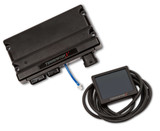Gear Ratios, Limited Slip and Your Mustang's Rear End
When it comes to bang-for-your-buck performance, it’s hard to beat differential modifications. Using a lower final drive and upgrading to a limited slip differential can improve acceleration. This is a great way to improve any Mustang, whether it's stock or has been highly modified.
Final Drive Ratio
This ratio is the number of times the driveshaft needs to spin to get the
wheels to spin: if the ratio is 2:1, the driveshaft should spin twice for the
wheels to spin once. This ratio is determined by the size of the pinion gear at
the end of the driveshaft and the ring gear, which turns the differential.
Increasing the final drive ratio increases mechanical advantage. This means
more torque is applied to the wheels, but this comes with trade-offs:
- Added torque at launch reduces drag strip times, but too much can cause traction problems.
- Passing power is increased, but higher engine speeds reduce fuel economy.
- Altering the ratio can move shift points, which can help the engine stay in its powerband.
- Top speed is reduced, but this should only be an issue on very quick cars.
Which Axle Does My Mustang Have?
All models except for four-cylinder Fox bodies use an 8.8 rear end. Early Fox
bodies may have a metal tag on one of the differential cover bolts. All other
Fords from the late 80s on use a sticker located on the outer end of one of the
axle tubes.
Mustangs use a 28-spline yoke, while most truck axles are 30 spline. This is a
major weak point on these axles, but it’s easy to upgrade to a 30 or 34 spline
yoke.
Traction-Lok differentials have a big S-shaped spring in the center of the
differential gears. There’s no way to identify this feature from the outside
other than reading the tag.
The 8.8 was built with the following ratios: 2.26, 2.47, 2.73, 3.08, 3.27,
3.45, 3.55, 3.73 and 4.10:1. Only the 2.73, 3.08, 3.27, and 3.55:1 ratios were
available with Traction-Lok. If you decide to upgrade to a Traction-Lok
differential, you’re limited to the ratios offered at the factory.
Here’s what came with your V8 Mustang from the factory:
- ‘86-’93 -- 3.27
- ‘94-’97 – 3.08 with a manual, 3.27 with an automatic or Cobra R
- ‘99-’04 – 3.27 or 3.55 in Mach 1 and ‘03-’04 Cobra
- ‘05-’09 – 3.31 with an automatic or 3.55 with a manual
- ‘10-’14 – 3.15, 3.31, 3.55 or 3.73 in Track Pack and Boss
- ‘15-’18 – 3.31 on standard models, 3.55 with the Performance Package, 3.73 with the Torsen Performance Package
We offer Ford Racing ring
and pinion gear sets in 3.55, 3.73, 4.10 and 4.56:1 gear ratios for solid
axles, as well as Motive Gear’s 3.90 and 4.30:1 gear sets.
The Independent Rear Suspension (IRS) used in ‘99-’04 Cobras and the current
Mustang use almost the same differential as the standard 8.8. The differential
is slightly different, so the gears aren’t interchangeable. Gearing choices are
limited to Ford Racing’s 3.73 and 4.09:1 gear sets.
Vehicle speed is measured using a sensor or cable at the transmission. This
needs to be modified to get the speedometer reading to match the vehicle’s
actual speed. Electronically-controlled automatics depend on an accurate speed
sensor. The wrong speed information can negatively affect shifting and lead to
transmission damage.
Traction-Lok
This is Ford’s name for their limited slip differential. It uses a clutch
system to lock the axles together if they get too far out of sync.
The gear oil used in Traction-Lok equipped differentials needs a friction
modifier to help the clutches engage. Royal Purple’s Max-Gear already contains
the necessary additives. Other oils can be mixed with Ford Racing's friction
modifier additive.
Ford Racing replacement clutch packs use carbon fiber discs that can handle
more punishment than the stock clutches. These are a great upgrade, even on a
stock Mustang.
Which Ratio is Best for My Mustang?
Speeds using different gearing can be calculated using this formula: (Tire
diameter x RPM) / (336 x Gear ratio) = MPH. 366 is derived from a calculation
of wheel speed for each MPH.
There are a few general rules of thumb when choosing an axle ratio:
- You probably won’t notice any major difference unless you’re moving two ratios away from your current setup, i.e. 3.27 to 3.55.
- The higher the powerband is in the rev range, the greater the benefit will be from going with a lower gear ratio.
- Going for a slightly lower gear ratio on an automatic will compensate for slippage, making it feel more like a manual.
- Anything over 3.55:1 will start to impact fuel economy on the highway, so it’s best not to go lower if you mostly drive your car on the street.
Get More from Your Mustang with Anderson Ford Motorsport
We don’t just sell Mustang performance parts, we’ve been testing and
building high performance Mustangs since the dawn of the Fox body era. From
final drive gear sets to friction modifiers, we have everything you need to get
more from your Mustang’s rear end.
Recent Posts
-
Bringing the Fox Body Mustang into the 21st Century with Holley Terminator X
Anderson Ford Motorsport has been in the Fox Mustang performance industry since 1989. One of the bi …22nd Oct 2021 -
Roush Supercharger install on a 2019 Ford Mustang
Check out this 2019 Ford Mustang before and after we installed a Roush Supercharger. …21st Feb 2020 -
All Blower Installations are not Equal.
Why Should You Choose a Company to Install Your Blower That Has a Dyno Facility In-House?Are all de …24th Jan 2020

